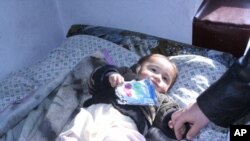As part of President Barack Obama's Global Health Initiative, different parts of the U.S. federal government are working toward making the world a healthier place, with a focus on the needs, aspirations and the diseases that affect the very poorest, said Dr. Rajiv Shah, Administrator of the U.S. Agency for International Development, or USAID.
President Obama launched GHI as the next phase of American leadership in global health. GHI builds on the foundation of PEPFAR and our investments in tuberculosis, malaria, and maternal and child health -- and expands their impact.
This approach saves millions of lives and helps developing countries address the diseases of extreme poverty, including malaria, tuberculosis, and neglected tropical diseases.
"We can build a new global health system that better connects what's happening in lab[oratories]. . . . with what is needed in USAID field sites. . . . If we can target the freed. . . .resources provided by the [Global Health Initiative] toward the expansion of those new scientific breakthroughs, I believe, by 2016, we can achieve great goals," said Dr. Shah:
"We can save the lives of over 3 million children. We can prevent more than 12 million HIV infections. We can avert 700,000 malaria deaths, most of which will be kids. We can ensure nearly 200,000 pregnant women can safely give birth, prevent 54 million unintended pregnancies and cure nearly 2.5 million people infected with tuberculosis."
"We need to focus our efforts on facilitating a continuum of invention and innovation from bench to bush," said Dr. Shah. And we also need the capacity of local community workers to invent solutions.
We saw a great example of this in India recently, said Amie Batson, USAID's Deputy Assistant Administrator for Global Health:
"They created an ambulance service in this particular part of India. ... But they discovered that the most important thing was having an extra seat in the ambulance, so that someone from the family could go with the woman to deliver the baby. Simply by identifying that, really looking at reasons why a woman wouldn't get in the ambulance, and by changing it and putting in this extra seat, they had a remarkable impact on then getting more referrals into the hospitals, and had these women delivering more safely, ... . And it had an actual impact on the maternal mortality rate in that area.
Advancing science, technology and innovation aimed directly at improving human welfare is one of America's core competitive advantages, said Dr. Shah. "If we can harness that capability for the poorest communities in the world, we can leave an unparalleled legacy in global health and in global development throughout the upcoming decades."
Working Toward A Healthier World

Different parts of the U.S. federal government are working toward making the world a healthier place, with a focus on the needs, aspirations and the diseases that affect the very poorest.




















